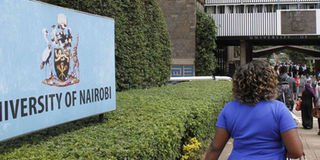Higher education: In crisis lies opportunity

The University of Nairobi. Universities now must build and take advantage of emerging technologies and engage virtual infrastructures. PHOTO | FILE | NATION MEDIA GROUP
What you need to know:
- In maintaining access through ICT capabilities, higher educational institutions can fulfil aspirations of not just the few but the many.
- Anticipate the immediate post-pandemic developments that are needed in education and associated fields where learning happens.
Governments and regulatory bodies — national and international — across the world are scrambling to respond to the current coronavirus pandemic.
The WHO Polio Oversight Body has just announced that it is suspending — for six months — global polio campaigns.
A global scourge that was almost eliminated, much like smallpox, as little as three years ago, may make a horrific comeback.
Uppermost in most peoples’ minds is the economy and what will happen to their livelihoods as work in many sectors comes to a grinding halt.
In East Africa, when preparations for the tourist season should be in high gear, we witness layoffs, with the attendant aviation industry reporting job losses in all but skeletal staff.
DIGITAL NATIVES
One of the key drivers of the economy and shaping the future is the education system.
Children have left schools and routines, students in higher educational institutions have been left in limbo, professional and certification examinations have been suspended.
However, there is some glimmer of hope. The University of Nairobi is set to move studies online.
Universities and higher educational institutions now have a distinct opportunity coupled with the capabilities we have across the world and the current needs of the day.
ICT is no longer a revolution but a reality — computers, apps, videoconferencing, and social media. The world has changed in the last few weeks and we are in the new normal.
For universities and higher educational institutions, this means three things. First, maintain access to learning for your students, the people we need to navigate increasingly uncertain times that lie ahead of us.
BE PREPARED
In maintaining access through ICT capabilities, higher educational institutions can fulfil aspirations of not just the few but the many.
It can increase access to more learners through online MOOCs, reduce costs, and promote principles of equity and social justice to make knowledge (freely) available to a much larger constituency than the privileged few.
Second, universities now must build and take advantage of emerging technologies and engage virtual infrastructures — not just physical infrastructures — to design learning fit for the 21st Century learner who is a digital native.
This virtual infrastructure can support two long-standing and immediate needs: personalise learning to the needs of learners and build a coherent system of education from early years.
Third, anticipate the immediate post-pandemic developments that are needed in education and associated fields where learning happens.
Understand the challenges on home-based learning and respond to them. Know what future disruptions we can expect and be prepared for them.
REPURPOSE EDUCATION
The United Nations noted five major challenges facing the world, and particularly Africa: demographic changes with the growth of youth as a percentage of the total population, urbanisation, climate change, conflicts and protracted crises (active in 34 of 57 in Africa), and disruptions caused by frontier technologies.
The Covid-19 pandemic is the catalyst we need to develop our educational systems.
We have inherited a system of education from other contexts, developed in a pre-industrial age, representing different cultures and values. These have not served us well.
We can now develop systems and build in skills such as ICT, integrate vocational and technical skills with academic learning, and give learners the characteristics and attributes they need: creative and critical thinking skills with compassion for fellow humans and the environment.
As the Chinese symbol for ‘crisis’ shows: in crisis there is both danger and opportunity. This is our moment to repurpose our education.
Anil Khamis is a senior lecturer at the University College London and the Aga Khan University in Nairobi



